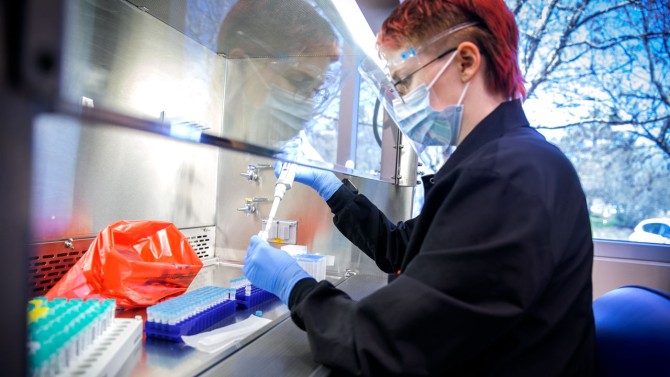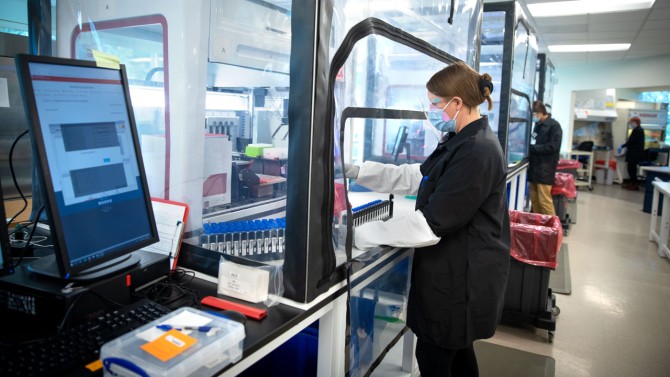Robust collaboration between community partners and Cornell has resulted in more than 2 million COVID-19 tests that have saved lives throughout the Finger Lakes region.
Partnerships fuel COVID testing lab’s success
By Susan Kelley
In March 2020, Dr. Beth Plocharczyk was desperate. She was scrambling to find COVID-19 testing materials so Cayuga Health System (CHS) could start collecting and testing samples in Tompkins County as the pandemic began raging.
CHS especially needed the clear fluid that preserves nasal swabs before they’re sent to the lab for testing, known as viral transport media.
“There just wasn’t enough to go around,” said Plocharczyk, CHS’s medical director of laboratories. “We were really struggling with, ‘What are we going to do?’”
She turned to Diego Diel, Ph.D., associate professor of virology who directs the virology lab in the College of Veterinary Medicine’s Animal Health Diagnostic Center, where they make their own viral transport media. Diel and his team provided more than 100 liters of the media to CHS, so they could start their testing program, Diel said.
“Cornell were such great partners to work with, because at the Animal Health Diagnostic Center, they’re used to testing herds, and we really are just a big herd of people in the community,” Plocharczyk said. “When you have a huge pandemic, you need a new lens to see it through, and the Cornell team was perfect to meet the challenge.”
From the pandemic’s onset, Cornell leaders imagined its COVID response with collaboration between the university and the community as a central tenet of the planning. “We were fully aware that what happened on campus would impact our community and vice versa,” said Dr. Gary Koretzky ’78, vice provost for academic integration and professor of medicine at Weill Cornell Medicine and a leader of Cornell’s COVID response. “The overarching goal of our strategy was to protect the health of those on campus and all residents of our region. We knew the only way we could accomplish this was to work hand-in-glove with community leaders.”
Two years into the pandemic, the collaboration between Cornell and its community partners has continued to evolve, resulting in robust surveillance testing that is credited with saving lives throughout Tompkins County and the Finger Lakes region. The Cornell COVID-19 Testing Laboratory (CCTL) joined forces with the CHS testing facility in late 2021. Combined, the lab has one of the largest testing capacities in the state, and on April 18 administered its 2 millionth test.
“The capacity and efficiency of the lab were really key to keeping the number of positive cases below average when compared to other areas in New York and even the country,” Diel said.
Tompkins County Public Health Director Frank Kruppa said he hasn’t had to worry about the availability of testing throughout the pandemic. “While many other counties around the state were struggling to find access to testing, we’ve never had that problem,” he said.
Nearly 300,000 residents of surrounding counties have had their samples tested at CCTL – 15% of the 2 million-plus tests, Koretzky said. “The testing meant people from Onondaga County to Schuyler County and others were able to isolate appropriately and mitigate the spread,” he said. “It certainly saved lives.”
The collaboration went both ways. CHS provides oversight to CCTL as the region’s federally certified laboratory, through its Clinical Laboratory Improvement Amendments (CLIA) license and certification by the Center for Medicare and Medicaid Services.
“We recognized immediately when the first confirmed case of COVID-19 reached the West Coast that we needed to dramatically increase our ability to test large numbers of people in the community,” said Dr. Martin Stallone, president and CEO of CHS. “As a result, in collaboration with our local partners at the Tompkins County administration and Health Department, Cornell University, Ithaca College and others, we opened one of the first mass testing sites in New York state. This space allowed us the ability to scale up to meet the community’s needs. This decision early on set the pace for our COVID response and reflects positively on our entire community.”
Under CHS’s certification, CCTL and CHS initially operated separate testing facilities, with the Cornell lab taking on CHS’ overflow, for about five months. In summer 2021, it became clear it would be most efficient to combine the labs at one site and use the most efficient workflow – the one developed at Cornell, Diel said.
While CHS had been testing mostly saliva samples, CCTL was designed to test nasal swabs, known as upper respiratory tract samples. But the overflow CHS saliva samples require special equipment and an extra processing step, and Cornell had neither the space nor the equipment to process them efficiently. “The saliva samples were actually being preprocessed at CHS’s lab at Brown Road, then transported to Cornell to be tested,” Diel said. “By moving the testing lab to Brown Road in late November, we were able to consolidate all the sample processing, intake and testing in one location.”
Added Lorin Warnick, Ph.D. ’94, the Austin O. Hooey Dean of Veterinary Medicine, “It was really putting the two together that gave the university and the community the capacity to meet the testing demand last fall and through the omicron surge.”
Communication among Cornell, the Tompkins County Health Department and CHS was constant and crucial, he said. And he praised the efforts of hundreds of people at those organizations, not only in the labs but also in information technology, human resources, facilities, accounting, administrative support and the legal arena. “It was really a lot of different teams that came together to make it possible,” Warnick said.
The collaboration means Ithaca and the surrounding regions have laid the groundwork for successfully dealing with future pandemics, Kruppa said.
“We now know we can do it,” he said. “It has put our community in a position, with the help of Cornell and Cayuga Health System, to know that if there is a novel disease sometime in the future, we have a roadmap to quickly get in front of it.”
Media Contact
Get Cornell news delivered right to your inbox.
Subscribe


